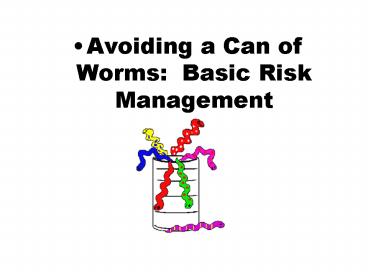Avoiding a Can of Worms: Basic Risk Management - PowerPoint PPT Presentation
1 / 30
Title:
Avoiding a Can of Worms: Basic Risk Management
Description:
Avoiding a Can of Worms: Basic Risk Management Presenters Patricia McGlaughlin Extension Specialist 4-H Youth Development patm_at_illinois.edu Sheri Seibold Extension ... – PowerPoint PPT presentation
Number of Views:298
Avg rating:3.0/5.0
Title: Avoiding a Can of Worms: Basic Risk Management
1
- Avoiding a Can of Worms Basic Risk Management
2
Presenters
- Patricia McGlaughlin
- Extension Specialist
- 4-H Youth Development
- patm_at_illinois.edu
- Sheri Seibold
- Extension Specialist
- 4-H Youth Development
- sseibold_at_illinois.edu
3
Worm Assessment
4
Risk Management Lesson Objectives
- Recognize the importance of risk management.
- Understand the basic terms principles involved
in managing risks. - Use a process for identifying, analyzing, and
managing risks. - Develop a risk management plan.
5
Wormwood Definition Quiz
6
Risks
- Acts or situation which allow the possibility for
harm or loss.
7
Risk Management
- Protecting assets by minimizing the potential for
negative outcomes.
8
Assets
- Things of value held by a person or organization.
- Asset 3 Ps
- People
- Property
- Perpetuation
9
Due Care
- Identifying a potential problem and trying to
avoid it.
10
Assumption of Risk
- Exposing yourself to a risk you know about.
11
Tort
- A civil wrong, outside of contract, committed by
one person against another.
12
Liability
- A state of being responsible or accountable for a
hazard or action.
13
Liability Insurance
- Insurance coverage to provide payments to others
for damages resulting from the negligence of the
insured.
14
Negligence
- Not taking care to avoid hurt or harm.
15
(No Transcript)
16
RISK IDENTIFICATION AND ANALYSIS
WORKSHEET Activity or Event RISKS TO
PERSONNEL (illness, injury, death, loss of
personal property, security, harassment, contract
liability, tort, liability) LIST RISK
EXPOSURES FREQUENCY SEVERITY
High
Low High Low
High Low High
Low
High Low High Low
High
Low High Low
High Low High
Low
High Low High Low RISKS
TO PARTICIPANTS (illness, injury, death, loss of
personal property, security, abuse, etc.) LIST
RISK EXPOSURES FREQUENCY SEVERITY
High
Low High Low
High Low High
Low
High Low High Low
High
Low High Low
High Low High
Low
High Low High Low
17
RISKS TO THE PUBLIC (injury, death, illness, loss
of personal property, etc.) LIST RISK
EXPOSURES FREQUENCY SEVERITY
High
Low High Low
High Low High
Low
High Low High Low High
Low High Low RISKS TO
PROPERTY/BUILDINGS AND EQUIPMENT (fire, theft,
vandalism, wind, flood, collapse, etc.) LIST
RISK EXPOSURES FREQUENCY SEVERITY
High
Low High Low
High Low High
Low
High Low High Low High
Low High Low RISKS TO PERPETUATION
(status of the group, organization or program
reputation, financial integrity) LIST RISK
EXPOSURES FREQUENCY SEVERITY
High
Low High Low
High Low High
Low
High Low High Low High
Low High Low Adapted by Mary
K. Munson, University of Illinois Extension, from
materials developed by Busler, Holroyd,
Johnson, Olsen, Skubinna, Oregon State
University Extension.
18
(No Transcript)
19
Retain Risks
- Accept the risk and prepare for the possibility
that loss will occur. - Most risks are retained, especially when the
consequences are deemed minor.
20
Reduce Risks
- Change the activity or conditions to decrease the
likelihood that loss will occur.
21
Share Risks
- Find someone to share some of the risk. Sharing
can be done by contract, agreement or insurance.
22
Avoid Risks
- Do not conduct the activity. If the risks are
too severe and the possibility too great, it is
unacceptable to conduct the activity.
23
(No Transcript)
24
RISK MANAGEMENT WORKSHEET
Activity Risk Strategies for Retaining
Risk Strategies for Sharing the Risk
Strategies for Reducing the Risk Risk
Strategies for Retaining Risk Strategies for
Sharing the Risk Strategies for Reducing
the Risk Risk Strategies for Retaining
Risk Strategies for Sharing the Risk
Strategies for Reducing the Risk Decision Acti
vity will be conducted ____Yes ____No. If Yes,
check the strategies that will be implemented
which will be part of the risk management plan.
25
(No Transcript)
26
Risk Management Tools
- Risk Management Info
- Risk Identification Analysis Worksheet
- Risk Management Worksheet
- Risk Management Plan Template
- Risk Management Plan Sample for Community
Service Project
27
Risk Management Tools
- Risk Management Info
- Adult Medical Form
- Youth Medical Form
- Code of Conduct for Events
- 4-H Member Code of Conduct
- Behavior Guidelines
28
Risk Management Tools
- Risk Management Info
- Certificate of Insurance Request Form
- 4-H Special Activities Insurance Comparison
29
Risk Management Tools
- Equine Program
- Permission to Participate
- Info for Equine Events Warning Signs
- Liability Insurance Application for Gaming and
Jumping Classes
30
Risk Management Tools
- Risk Management Info
- Incident/Accident Investigation Form
- Informed Consent/Parental Release Form
- Photo and Video Release
- Youth Description for Trips
31
Risk Management Tools
- Volunteer Screening
- Volunteer Application
- CANTS Check
- ISP Conviction Information Name Check
- Sex Offender Registry
- Volunteer Reference Form
- Volunteer Role Description

















![NOTE: To appreciate this presentation [and ensure that it is not a mess], you need Microsoft fonts: PowerPoint PPT Presentation](https://s3.amazonaws.com/images.powershow.com/6744008.th0.jpg?_=20150612119)
![NOTE: To appreciate this presentation [and insure that it is not a mess ], you need Microsoft fonts: PowerPoint PPT Presentation](https://s3.amazonaws.com/images.powershow.com/6265818.th0.jpg?_=20200727054)












